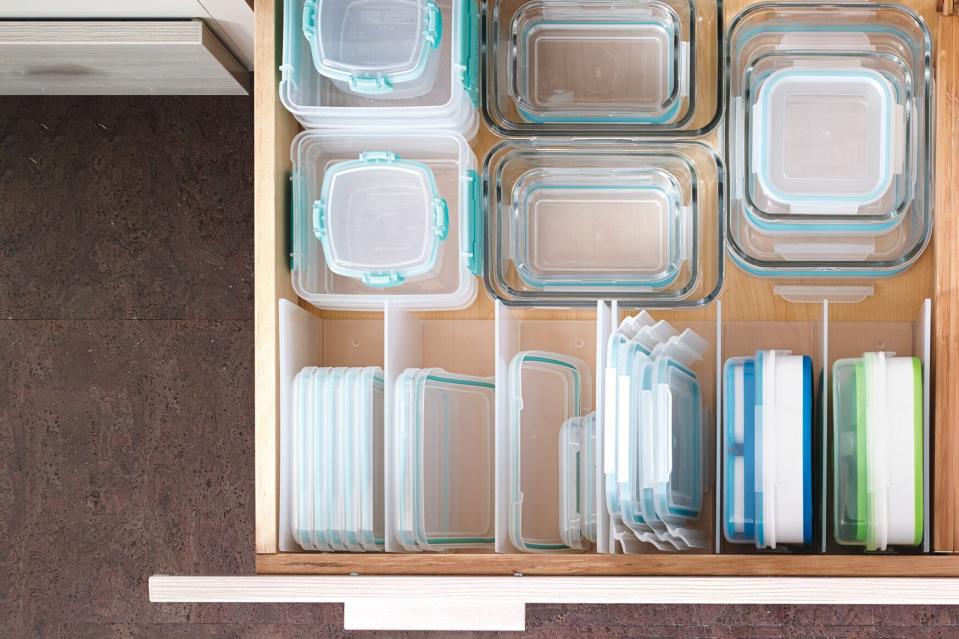How to Organize Your Food Storage Containers the Right Way
TABLE OF CONTENTS
On This Page
Take Inventory
Keep Like With Like
Discard Excess Inventory
Buy What You Need
Create an Organizing System
Ordering takeout food, packing your lunch, and storing leftovers from dinner can all lead to an influx of small food storage containers in your kitchen. This, in turn, creates the nearly impossible task of keeping all those containers organized.
"This is really a universal challenge," says Lisa Zaslow of Gotham Organizers. "The pace of change for these containers is practically daily, and if you don't put things back in the exact right spot, things get chaotic." But with a few simple organizing tricks, you can keep everything from your smallest dressing container to your largest tub exactly where it belongs once and for all.
Related: These 11 Pantry Storage Containers Are So Beautiful, You Won't Want to Tuck Them Away

Annie Schlechter
Take Stock of What You Have
Before investing in new containers or deciding where to keep the ones you already have, start by collecting every piece already in your arsenal—including those in your cabinets, in the refrigerator, and in the dishwasher. "Food storage containers seem to multiply like fruit flies," Zaslow says. "They sneak into our homes when we order takeout and when we take home leftovers, and lids and bottoms seem to get tossed at different rates." Once you know what you have, you can then figure out what's missing or damaged.
Pair Your Containers With Their Lids
Pair as many containers with their lids as you can, and then weed out the extras. "When organizing anything, the first step is to clear out clutter," says Zaslow. "Get rid of any unmatched pieces, any that are past their prime, and any you don't like." This includes saying goodbye to extra takeout containers you know you won't use. "Those are made to be temporary," says Zaslow. "They don't have as good of a seal as something you would buy. You probably already have something better, so let them go."
Discard Excess Inventory
The next step is to figure out exactly how many containers you need, as well as what purposes you need them to serve. Do you have leftovers to pack up after dinner every night? How many people in your family use food storage containers at lunch? Do you need glass containers for reheating extra food? "A household only needs one, maybe two sets of leftover containers, depending on the size of the family," says Neitra Rose of Organizing Lifestyles.
To keep track of what you use and what goes untouched, put a small piece of masking tape on the bottom of each container and take the tape off as you use each piece. "After a couple of weeks anything that still has tape on it can probably be let go," Zaslow says.
Buy What You Need
If you've found that most of your collection is run-down takeout containers and mis-matched sets, you may need to buy new pieces. "The fewer different types and sizes of container you have, the easier it is to organize them and the less space they take up," says Zaslow. Sets that stack or nest, collections with mix-and-match lids, and store-flat containers all help you maximize your space.
"For your lunch containers, get a different color for each family member," says Rose. "Everyone knows which set is theirs, and if something comes up missing or accidentally left somewhere, then you will be able to identify what needs to be replaced."
Create an Organizing System
Designing an organizing system for your food storage containers starts with designating specific spots for each category. "When everyone in the house is putting things in different places, it is an indication that there isn't a specific home for something," says Rose. If you plan to use pieces interchangeably—for on-the-go snacks, lunches, and at-home food storage—keep them all in the same drawer or cabinet. On the other hand, if you've specified containers for different activities, store them separately.
As a general rule, it's best to keep lids with their corresponding containers. "Arrange containers to fit your space, putting in the largest ones first, and fitting the smaller ones around them. Nest and stack related containers as much as possible," says Zaslow. Small cabinet shelves maximize vertical space, while baskets that corral containers and lids in your cabinets are especially easy for kids to navigate.

